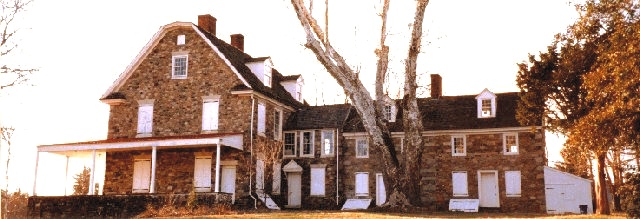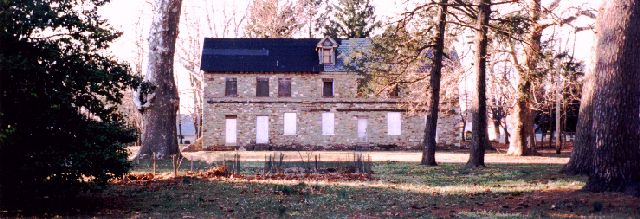
Dating the Structure
![]() "By force of intellect,
activity of mind, strong pre-disposition to take part in public affairs,
integrity, and intelligence, the Pemberton family for nearly a hundred
years was the most prominent in Pennsylvania." 1
The ancestral home of the Pemberton family is located on the Newportville-Fallsington
Road in Bucks County and has been known for two hundred and ninety years
as "Bolton Farm." Historically and architecturally, the house is one of
the most significant in Pennsylvania; nearly every one of its inhabitants
since the days of William Penn has influenced the course of history in
the state.
"By force of intellect,
activity of mind, strong pre-disposition to take part in public affairs,
integrity, and intelligence, the Pemberton family for nearly a hundred
years was the most prominent in Pennsylvania." 1
The ancestral home of the Pemberton family is located on the Newportville-Fallsington
Road in Bucks County and has been known for two hundred and ninety years
as "Bolton Farm." Historically and architecturally, the house is one of
the most significant in Pennsylvania; nearly every one of its inhabitants
since the days of William Penn has influenced the course of history in
the state.
Now that the attempted demolition of the house is an issue of the past and restoration work is beginning, a reevaluation of the historical and architectural importance of Bolton Farm is in order.
Bolton Farm has been altered considerably over the course of nearly three centuries of use and what now exists is a complex structure of some twenty-seven rooms built and rebuilt as demands upon it have changed and expanded. Architectural evidence alone is sometimes conflicting and it is not the purpose of this paper to affirm indisputably certain dates of construction and physical appearances. Rather, the purpose is coordinate the architectural evidence at hand with the historical evidence that has been researched up to now, in order to gain a clearer picture of the history of the house as a whole and to elucidate the issues which will become increasingly important as restoration work proceeds.
The first issue to arise is that of the original date of the house. After their families had arrived, on November 17, 1683, Phineas Pemberton purchased five hundred acres of land and built a house, probably of English frame construction which was called Grove place. Finding this location damp and unhealthy, they finished another house in 1687, five miles from the Delaware, the beginning of the Piedmont. This house was called "Pemberton" or Bolton" because the family was from Bouton, Lancashire. This lintel of this house is in the possession of the Pennsylvania Historical Society and reads:
P. P. & P. 2 Mo. 1687
This lintel is clearly from a house of English frame construction 2 and since the oldest section of the house is stone, conflicting evidence arises. Several theories are possible. That part of Bolton built by Phineas could have been of English frame construction and later rebuilt in stone in the early eighteenth century. It is also possible that the original house was indeed stone. Several factors become important to this issue. First, as to the validity of the 1687 date, the fireplace in this section is of a very early type (before 1700) being a low Jacobean arch. A strong case exists that is the original fireplace stack of the Phineas Pemberton house. 3 Even if the original walls were taken down at some later date, this fireplace stack validates the 1687 date. Secondly, there is a line in the stone of this section that occurs at the bottom of the second story window sills. It is possible that the 1687 house was one and one half stories in height (either stone or wood) and later raised to two full stories. The one and one half story form of the house would have been more consistent with typical construction of the time. The break line in the stone complete with quoins, indicates that a stone structure did exist at some point independently from the stone section to the east. It is not unlikely that Phineas would have built of stone, after living in the English frame Grove Place. It is possible that the lintel is from Grove Place and not Bolton and that Bolton was indeed originally stone.
A major difficulty in dating stone is that the stone-masons of Bucks County changed their craft little over the course of the eighteenth century. By studying the stone itself, one probably will not learn much. The architectural evidence obtained from doors and windows dates this section at around 1790. Yet we know that is surely existed before this date. The key to this is that when additions were made, the entire structure was "modernized." new windows were added, old wood was replaced. The 1790 date for this section probably indicates its second modernization.
The section to the east of the Phineas Pemberton house has been dated at 1810-1820 4 , after the Federal style west wing was added in 1790. This would mean that for one hundred three years, the house existed only as the original, one-room 1687 house. This is very unlikely, considering the growth of the family in size, wealth, and prominence. By shifting attention from purely architectural evidence to the history of the family, clues to the size and use of the house might be found.
Upon his death in 1702, at the age of fifty-three, Phineas Pemberton's will stated, " I also give, devise, and bequeath unto my son Israel, the housing and lands I now live upon and called by me Pemberton and 354 acres of meadow and upland... my daughter Abigail shall have the chamber over the hall in my now dwelling, herself with fireplace and free liberty of fire and passage into and out of same until she married. My wife Alice shall remain so long as she does not remarry."5
Although, Israel Pemberton, Sr., merchant and politician had a residence in Philadelphia, Bolton was still used as the family homestead, and it seems indeed plausible that the original 1687 section would be far too small to accommodate a family of this size, even if only temporarily. From the history of the family, then, we have a situation which would support the thesis that the eastern portion was built between 1710 and 1739.
Thus, during the eighteenth century, Bolton probably consisted of two sections, one built by Phineas in 1687 and the other by his son Israel upon his success as a merchant, before 1739. The earlier structure was probably one and one half story stone; Israel increased it to two stories, rendering it more consistent in form with early eighteenth century houses in the areas such as the Thompson-Neely house in Washington's Crossing. Wyck in Germantown was built in 1690 and 1720 and is also a long succession of rooms. "This succession of additions helps to explain the irregular placement of doors and windows..."6 After Israel, Sr.'s addition, the house measured 18 by 46 feet, each room on the ground floor having a central south door flanked by two windows. The north facade of the addition had two windows, that of the original house being similar to its south facade. This house served Israel well as a country house. Israel, Sr., had three sons, Israel, Jr., James, and John all of who were successful.
Mary Pemberton-Morris, daughter of James, and her husband Anthony built the west wing of Bolton Farm. The addition is a fine gambrel-roofed example of the Federal Style, consisting of two large parlors and a hall with a handsome staircase rising to the two chambers above. This house was constructed of wood frame with lock-joint boards which gave the appearance of clapboards. It was modernized at this time, accounting for the late eighteenth century dates of its detailing. The circulation hall of the Federal house connected directly into the circulation zone of the older structure so that the functional relationship of the two was quite efficient. It is interesting to note that the house at this stage of its development is very similar to Philadelphia townhouse plans of the time. Such buildings typically consist of a side hall with double parlor, the distinctive Philadelphia "piazza," and rear service wing.7
The interiors and exterior of this Federal house were pale yellow with white trim. Finely detailed fireplaces, wainscoting, and door and window trim graced the interior. A hall way arch defined the staircase.
Mary's son, James Pemberton-Morris, inherited Bolton from his Grandfather. James gave Bolton to his Father, Anthony, who resided at Bolton from 1790 to 1861. James' children inherited from Anthony who gave it to their sister, Isabella Pemberton-Morris.8
At this time the fourth major addition was constructed (1860's). The 1790 wing was extended to the north on two floors, transforming the side hall plan into a center hall plan, creating on the first floor a 16 by 34 foot room with fireplace and on the second floor, two chambers without fireplaces. This addition was rather insensitive to the 1790 wing. The proportions of the west window of the first floor are awkward (15 lights over 15) compared to the elegant Federal windows (12 over 12). On the second floor, a double window seems completely out of place; yet in an odd way it balances the west facade and creates a composition of considerable interest
Sometime around 1830 to 1840, the bake oven was built to the east of the Israel Pemberton section. it is very unusual in its large size and is an English type with clay joints, rather that a German type.9 It was built to accommodate the increased baking needs which grew in the nineteenth century with the development of Bolton Farm into a large country estate.
Isabella Pemberton-Morris gave the estate in turn to her cousin Effingham B. Morris. In 1913, the entire west wing was encased in stone and two datestones reading:
A. M. & M. P. M. 1790
were placed at the gable ends for obvious prestigious reasons. A veranda with herring-bone brick paving was add which featured unusual skylights above the eaxisting windows. In this way, light was not cut off from the interior rooms. More rooms were added between the 1687 section and the 1790 wing on the first floor. Thus, in the early twentieth century, the house became the victim of the Colonial Revival, although architecturally it did become consistent in material and transformed into a true mansion of considerable size and stability. A stone house for the tending farmers was built at this time to the northeast, creating a courtyard behind the early eighteenth century portion of the house.

Anthony Morris' ties to the University of Pennsylvania resulted in the use of Bolton as an experimental farm, perhaps as early as the 1820's. In 1938, Effingham Morris' children gave the house to the University. United States Steel purchased the property in the late 1940's to house dignitaries planning the construction of the Fairless Works on the Delaware River. William Levitt bought the house and constructed Levittown around it in 1952, leaving six acres from the original 354. The property was given to Bristol Township to use as its municipal offices. When the Township vacated the property in 1966, professional as well as amateur vandalism occurred. After many demolition threats by safety-conscious fire marshals, the house is now registered as an Historic Site and is deeded to the Bucks County Conservancy. Restoration has begun with the bake oven and the Israel Pemberton addition by Mr. Edwin Brumbaugh and Mr. Albert Ruthrauff.
The next stage of historical documentation of Bolton Farm should be the research of the Pemberton papers, of which there a 70 volumes in the Pennsylvania Historical Society in Philadelphia. Inventories of possessions, references to construction and physical conditions, and other pertinent data must be sifted from the Pemberton Papers. Exploratory demolition may conclusively settle disputes concerning the conflicting architectural evidence.
Endnotes